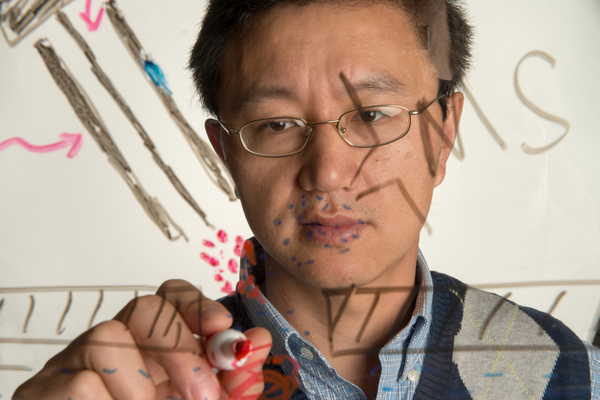From finding new compounds for drug development to detecting narcotics or explosives at crime scenes, scientists have relied on mass spectrometry to identify molecules.
Dr. Hao Chen is developing a portfolio of technologies that can expand the capabilities of this classic technique.
“Our research focuses on the new mass-spec innovation based on newly discovered ion chemistry and novel instrumentation,” says Chen, Associate Professor of Chemistry & Biochemistry at Ohio University.
Cutting Preparation Time Entirely
In 2004, Purdue University scientists developed a technique called desorption electrospray ionization (or DESI) that can analyze solid samples, which is built on a Nobel Prize-winning method for creating an electrically charged mist. Chen adapted the DESI technology to include analysis of liquid samples and has cut the preparation time (which can last from minutes to hours in the laboratory) entirely.
Chen’s inventions also can help analyze compounds more precisely and quickly, which could, for example, increase the number of compounds drug companies could explore as treatment candidates in a shorter time period, getting new therapies to market more quickly.
His technologies also may aid basic research in areas such as imaging flaws in human protein folding, which has been found to be the underlying cause of major neurodegenerative diseases such as Alzheimer’s.
Chen’s research enables scientists to combine the power of mass spectrometry with two other important techniques in the chemist’s toolbox, electrochemistry (chemical reactions triggered by electric voltage) and liquid chromatography (which separates mixtures), he notes.
Each year, Ohio University’s Technology Transfer Office looks for new campus inventions that can be patented, licensed to a company, and manufactured and marketed for commercial, industry, or military use. In some cases, faculty, staff, or students might license the technology back from the university and launch their own startup companies to develop the products. Otherwise, the university works with established and startup businesses around the globe to take these ideas from the laboratory to the marketplace. Read more in Compass.
Four Projects in Chen’s Lab
Liquid sample DESI — the Study of Electrochemistry, Protein Conformation and Reaction Kinetics by Mass Spectrometry
“We have extended the desorption electrospray ionization (DESI), an ambient ionization method, to the direct analysis of liquid samples. Due to its direct sampling and ionization properties, this Liquid Sample DESI-MS is versatile and has unique applications. For instance, it allows us to study electrochemistry, protein conformations, fast reaction kinetics, atmospheric pressure ion/molecule (or ion/ion) reactions, single droplet microextraction, etc.,” he notes.
Selenium Chemistry for Biological Thiol Derivatization
Selenium reagents such as ebselen can be used to selectively and rapidly derivatize thiol peptides/proteins for mass spectrometric analysis. This reaction is highly selective, rapid, reversible and efficient. For instance, the Cysteine121residue of β-lactoglubin A can be labeled using ebselen with quantitative conversion in 30 s.
Protein Footprinting Using Fast Photolytic Oxidation of Protein (FPOP) Method with Various Oxidants
Chemical footprinting of proteins has long been proven to be an efficient method for probing protein-protein interactions. FPOP achieves protein oxidation on a microsecond timescale, making it a strong candidate for protein footprinting. The objective of this project is to develop new FPOP methods with novel laser-generated oxidative chemical probes such as the highly oxidative sulfate radial anion SO4-▪.
Atmospheric Pressure Ion Chemistry
Tandem mass spectrometry is invaluable for chemical structure elucidation via examination of fragment ions after the activation and dissociation of gaseous precursor ions. Recently, an ambient ion thermal dissociation method has been established which allows the isolation and re-ionization of neutral fragments of peptide/protein ions at atmospheric pressure outside of the mass spectrometer. This method can also be used to seek green chemistry approaches in reaction methodology. For instance, ionic Borsche-Drechsel cyclization is feasible without the need for conventional acid catalysts.
Portions of this article by Andrea Gibson appear in the Autumn/Winter 2013 issue of Ohio University’s Perspectives magazine.




















Comments